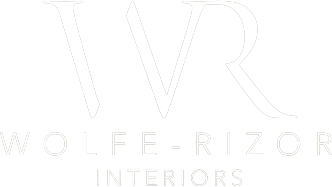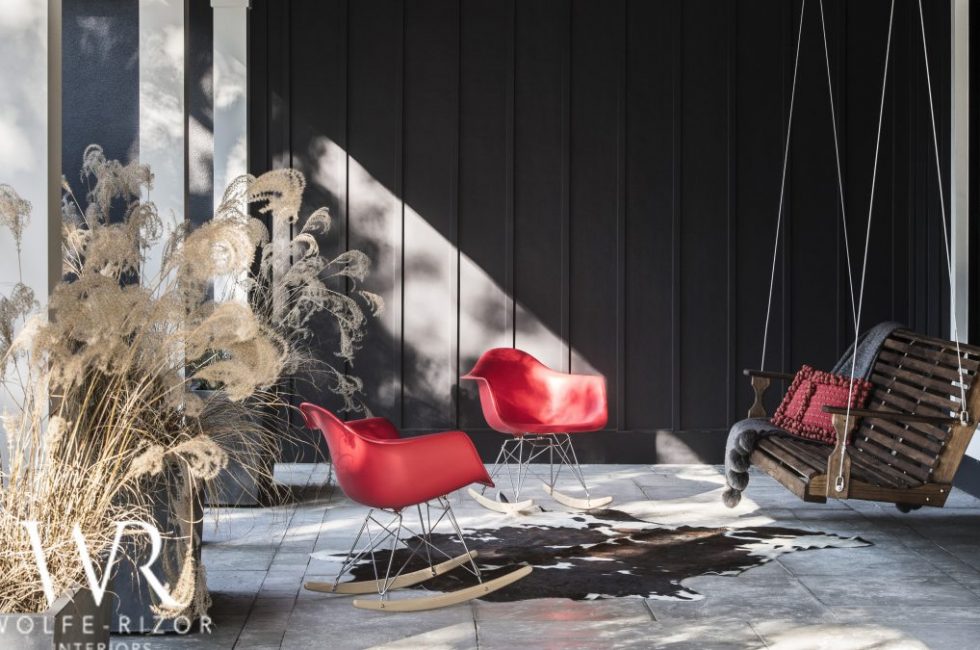The dialogue continues between Abigail Rizor and her longtime client Betsy Pokorny, at the Winter Park home that they recently collaborated in creating. After fifteen years together, they tend to finish one another’s sentences, and their conversation reveals a lot about how the Wolfe-Rizor aesthetic and design process has evolved over time.

Abby: That’s a good question, because I don’t even know.
Betsy: I remember walking into … gosh, I can’t remember who recommended you? I know it wasn’t an internet thing.
Abby: Yeah, I don’t think the internet existed.
Q: It was 15 years ago?
Betsy: And I remember walking into your old office and thinking, “This is going to be great.” I saw the antlers on the wall, and just the feeling in the office and everything. It was a good fit from the beginning.
Q: So the thing that you were interested in that drew you together was the hunting style? And then you both have obviously morphed into very different styles

Betsy: We spend a lot of time in Aspen. And so we love that, so we’re trying to incorporate the southern style with more of a western feel.
Abby: But I wouldn’t say hunting. Okay, so I always think that’s such a funny thing. Because I know people love hunting and stuff. That’s not my thing. But I do love hides, and you’ll see … hide on the porch, a hide in the closet. And antlers, I have antlers in my bedroom and stuff that I painted. Well, those used to be in my living room. But I don’t go out hunting.
Q: You don’t wear camo.

Abby: So when designed the family room, we found a large cowhide rug in shades of gray that we all absolutely loved. We ordered it but the company had sent the hide folded up into a tiny square in a box, and the rug had all these wrinkles in it. And I was juggling it with a steamer trying to get wrinkles out of the cow. Oh my God, my mother. Every time she comes home I’m doing something crazy like…
Betsy: Ironing out cow hide.
Q: But it worked. So you had this western influenced style, but then your style has changed a lot. When you two came together 15 years ago you had a lot in common at that time, and would you say that you kind of changed together, over time?

Betsy: “Which one is not like the other?”
Abby: “Which one is not like the other?” Which I would think is a very simple thing to do, but it’s not for a lot of people. So you just see a pattern that’s running through people’s things. So a lot of these things, like I said, were in their old house. They still appreciate them.
Betsy: Yeah. It all fits, it just feels different.
Q: So, when you’re integrating the antique pieces and the older stuff, I noticed there’s a tray in the dressing room with a lot of small decorative pieces, but it’s all in one place. Do you have a way that you work with that?
Abby: Well, I’m not into little knickknacks.
Betsy: No, she’s not (laughing).
Q: Right. So you just sort of keep it in one place.
Abby: That’s my OCD.
Betsy: “Let’s leave that in the bedroom.“ Okay.
Abby: I always say, when you go into houses and people have 900 frames. You can line them all up on a buffet, but I have clients get an album instead. You put them all in an album, then you can flip through them and enjoy, without clutter.
Betsy: Right. Use a pretty book. You don’t need to have them out. And I do like how I think you were saying with the powder room, we have a lot of significant family old photos, but also a family tree, and something that I’d gotten from one of my siblings. All these certain things that mean a lot. And I think you had said, when people are in a powder room that’s where they really have time to take a minute and look at your pictures and it’s not such a rush.

Betsy: They can just kind of look, and you don’t have to go into a whole long soliloquy of your great-great-grandmother’s…
Q: But then you can never get them out of there, probably.
Abby: Yeah, exactly.
Betsy: So people love that. I think it’s a little bit unexpected because we don’t have a lot of stuff on the walls, personal things, so they like that.
Abby: When we grew up here in Winter Park, Cork and Cleaver used to be this steak restaurant, and they had a chalkboard in the men’s room. So my brothers would spend the whole time in the restroom. My parents loved it, because they were just on that chalkboard.
Betsy: Yeah, because the parents could enjoy their quiet time!
So in this installment of “Conversation Pieces, we’ve learned about how Abby likes to display family photos and how Abby and Betsy inventively used the guest powder room as a storytelling venue filled with family heirlooms. Stay tuned for the third and final part of this enlightening designer and client interview, coming next month!
Photos by Stephen Allen Photography


